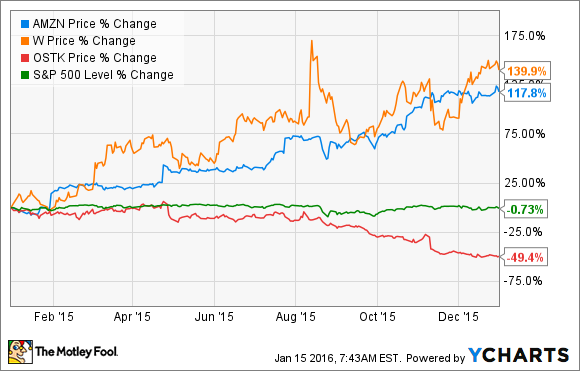What: Online retailing produced some big winners in 2015 -- and the occasional big loser as well. Shares of Amazon.com (AMZN 1.30%) gained 117.8% last year, according to data from S&P Capital IQ. Wayfair (W 5.52%) one-upped its larger rival with a 139.9% leap. At the same time, veteran e-tailer Overstock.com (BYON 3.88%) plunged 49.4% lower.
So what: Sector leader Amazon fired on all cylinders all year long. The company delivered four positive earnings surprises, twice turning an expected loss into actual profits. Amazon can look back at trailing sales of $100.6 billion, an 18% year-over-year increase. Trailing earnings stand at $0.70 per share, up from a net loss of $0.47 per share a year earlier. Free cash flows nearly tripled to $7.1 billion. This is e-tailing done right, and it shows in Amazon's results.
Up-and-comer Wayfair didn't fare much worse. In many ways, the smaller and nimbler home furnishings specialist just plain outperformed Amazon. The company is still operating at a net loss, but keeps delivering smaller losses than expected. Sales are growing at an annual clip of 59%. In the October report, trailing free cash flows turned positive for the first time in Wayfair's short history. Noted short-selling firm Citron Research took a spirited swing at Wayfair in August, but investors have largely shaken off Citron's accusations by now. And Wayfair shares continue to soar.
Citron actually compared Wayfair to Overstock, using the older business as a Platonic archetype of failed online retailing business models. That's not much of a stretch. Overstock missed Wall Street's earnings targets in each of its last four reports, sometimes by massive margins. Annualized sales are up by a measly 10%, earnings have been slashed in half, and Overstock's cash flows are now negative. The company is running out of cash reserves and started taking on debt.

Now what: These three e-commerce companies stand at very different points in their respective histories.
Wayfair is the young, hungry, single-market specialist with the fantastic growth rates and sky-high valuations to boot.
Amazon is the mature giant with tax-effective (as in very low) earnings but massive cash flows, and with plenty of growth left in its engines.
And Overstock continues its multiyear journey toward Penny Stock City as its theoretically brilliant business model suffers from poor distribution and even worse customer service operations.
Overstock should only appeal to ambulance chasers and fearless speculators. Long-term investors are far better off with the hungry hyper-growth of Wayfair or the mature market-defining authority of Amazon.






